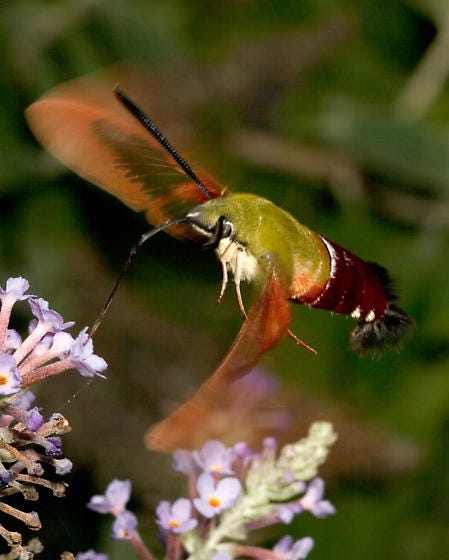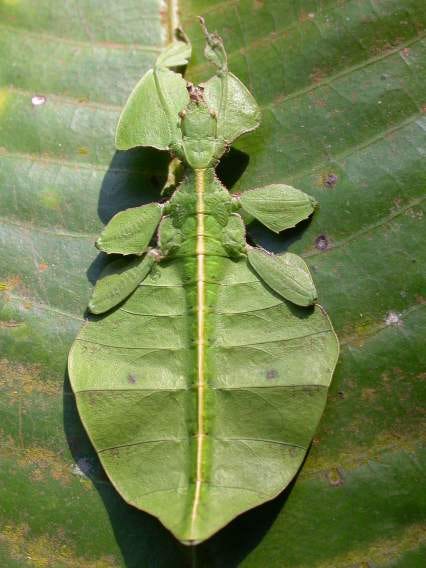
The first time I saw a hummingbird clearwing moth, I was working for the summer as a lifeguard at my town pool, teaching children to tread water and refereeing open swim. Adolescence being a phase of mimicry, I also was observing the habits of my two co-workers with great care. They were both older and, to me, impossibly popular: Mark played basketball and was the youngest of a large cast of siblings; he wore his charisma with a kind of baffled entitlement, like an older brother’s football jersey. Annette, the only female member of our cross-country running team, was an amasser of vast lonely mileages, and I came to understand that running was her costume and refuge.
Though both of them were as broken and frightened as any other teens I knew, Mark and Annette craftily hid their vulnerabilities beneath the adornments of popularity, and as the youngest of the pool staff, I felt like a different form of life altogether. As Annette did with her running, I made water my refuge, prizing its dappled, blurry costume, the liquid freedom it afforded.
The pool glimmered inside dusky barn of concrete block tacked onto one end of the high school. A garage door opened on a sun-scorched patio, where eighth-graders lay out on towels, working on their long-term dermatological outcomes. Annette usually took her guarding shift there, resplendent in her Ray-Ban oblivion, a feral, governing angel in repose just outside the dark and dinsome pool. One afternoon, Mark and I were tending the window where swimmers checked in for lessons and open swim. Shoals of children already splashed pealingly in the water while we gazed out on the bare gravel drive and the distant fringe of trees. From out of the humid, luminous air beyond the safety glass, an improbably-heavy insect helicoptered into the entryway: the size and shape of a large-caliber bullet, wings a buzz-saw blur of menace, head honed to hollow-point protuberance, abdomen flocked and finned. It was army green overall, and lovely as a weapon. It was some kind of hornet, we agreed, and when it settled on the ceiling, its windowpane wings focused instantly into stillness. Mark boggled, cursed, huffed in wonder. “We can’t let it get into the pool area,” he concluded, ducking to peer upward. The legs of the rusty folding chair shrieked as he pushed it into place beneath the creature’s perch. I wanted to stop him, but stood powerless, entranced by the prodigious bug. Wielding a foam paddleboard, Mark crouched on the chair and thwacked upward with frantic strength. The insect burst like something ripe, its innards raining down, one jetting gob sticking to Mark’s upper lip like a spitball as he squinched his eyes shut and froze in nauseated agony. After a horror-frozen spell, he howled and fled to the locker room.
I didn’t recognize the insect Mark had squished. Only years later, recollecting the moment, did I realize that it had been a hummingbird clearwing moth (and harmless as such). Strange how memory can so surely name a once-nameless thing.
Hummingbird clearwing, Hemaris thysbe: the scientific binomial and the common name a weave of intersecting memorabilities. The hummingbird picture is clear in the blur of its wings and the velvet heaviness of its body as it hovers and swerves amid nodding flowers, in the way it buries its snout in blossoms to drink nectar with a reticulated, surgical tongue. But is the moth a picture of the hummingbird, or the bird a reflection of the moth? Moths have existed much longer than hummingbirds—and many of the clearwing moths (the Sesiidae, a family some 1500 species strong) resemble bees and wasps as much as birds. To mimic a stinging insect confers protection. But the costume of Hemaris thysbe is distinctly that of the hummingbird, which arose around the same time the first clearwing moths appeared. It’s hard to see the benefit in looking like a hummingbird—or, for that matter, in a bird looking like a moth. Their shared traits seem convergent, shaped by the constraints of the nectar-sipping life. Seen this way, then, are they a kind of memory of flowers? What might it be in a hummingbird or a moth that is the striving of flowers to remember?
Massed blossoms hide predators; the bright bouquet conceals clasping beaks and pious, poised mantid claws. To hover is to picture the lunge that haunts the petals. Other insect structures recall the wiles of flowers themselves, like the then-unknown sphinx moth whose existence Darwin postulated upon observing Madagascar’s comet orchid, whose nectaries hide at the bottom of slender spurs nearly a foot deep. The known sphinxes had mouthparts no longer than their bodies; pondering the comet orchid, Darwin suggested that a companion moth would be found with a tongue as long as 10 or 12 inches. The moth in question, when identified two decades later, was given the subspecies name prædicta. The moth’s long tongue was not a foretelling, however, but a memory trace, the slow evolutionary co-inscription of orchid and insect.
There’s a lot of current interest in the question of plant intelligence: do they feel, plan, communicate? In their very forms, plants remember the creatures that depend on them. The Americas are dotted with trees whose fruit once fed now-extinct megafauna: the Osage orange of the American Midwest, the jícaro or calabash tree of Mexico, even the avocado, all seem to have evolved for dispersal by the likes of ground sloths, mastodons, and gomphotheres. With massy fruits, tough outer shells, and durable, slippery seeds, they mostly confound the smaller mouths left behind by the Quaternary extinction event that arrived with humans in the Americas. Once flourishing widely, these trees withdrew into refugia in the long post-extinction era, until people began to cultivate them. Growing up in Illinois, I knew the fruit of the Osage orange as the “hedgeapple,” a name that recalls the tree’s use as a windbreak and boundary marker on nineteenth-century farms. But the dense, moist, friable fruit, softball-sized, which we piled in the woods and pelted each other with in pitched battles, evolved to appeal to the grinding molars of extinct proboscideans. I look at these fruit now and feel the crunch of the mastadon’s bite, feel the tuberculate rind tearing, the milky latex mixing in the great chomping mouth, the cucumber scent of the flesh on the exhale.

And then there are the stick insects, in the order Phasmatodea. Named for ghosts and apparitions, the phasmids seem an order in the religious as much as the taxonomic sense, a sect of phytophiles who give themselves wholly to the habit of stem and leaf. And yet these critters are hungry ghosts, who eat the foliage they ape. Phasmids are mostly nocturnal, spending the daytime almost cataleptic, trembling in the wind, seeking shade in the foliage they mimic. At night, they rise and move about like the dream-bodies of the leaves.
I think of those words that come unbidden to Mrs. Ramsay In To the Lighthouse: “And all the lives we ever lived and all the lives to be are full of trees and changing leaves.”

Am I too a phasmid, a hungry ghost? That afternoon by the pool, without knowing how to read the hummingbird clearwing moth, Mark and I had opened another archive: we remembered how to fear, and how to strike. The twitch, the recoil, the startled heart, the sudden intake of breath—who wrote this script? What ancestral horrors have settled into the shared body of the species, leaving their trace in triggers?
I want to think of mimicry as a form of memory, a distinct scribal hand in the broad magisterium of evolution’s uncanny inscriptions. Mimicry depends on memory for its propagation, as predators’ past encounters with toxic prey must be too memorable for heredity to ignore. The similarity of bees, hummingbirds, and clearwing moths makes a more complicated record, however, as none of these creatures are especially toxic or dangerous. Instead, their traits are convergent—the memory not of toxic encounters, but shared ways of being.
In its Latin name, the clearwing moth indexes another register of memory: Hemaris thysbe: “Thisbe’s blood.” Upon finding Thisbe’s cloak torn and bloodied beneath the mulberry tree and taking it as evidence that his beloved was killed, Pyramus threw himself on his sword. The moth’s wings are fretted with sanguine cames, blood-red veins that recollect the gory traces on Thisbe’s shawl. Before the taxonomists thought of hummingbirds or hornets, they remembered their Ovid.
Another desert tortoise conservationist, Tim Shields, who estimated that he’d logged 35,000 miles on foot in more than 45 years, felt a sort of spiritual apprenticeship with the animal. “My career has been the discovery of this earthling that has figured out how to survive,” he said, noting that the species has been around for as long as 20 million years. “I mean, a desert tortoise has seven ways to drink rainwater that I’ve witnessed in the field. We have this lesson to learn, that we can give to other earthlings.”
—Mark Sundeen profiles the itinerant naturalists who find human remains in the Mojave desert in the latest issue of Outside. This ragtag, tight-knit community of tortoise counters crisscrosses the desert to save an endangered species; when a tortoise-counting couple find the remains of a long-missing mother, their world intersects with the human misery the desert attracts—and the mystery of that misery, as confounding as the natural world is wondrous.
These images are splinters of a deeper fracture: our growing estrangement from the natural world, a severance that has kindled climate change and ushered in the sixth mass extinction. Perhaps more importantly, on a smaller scale, they are eroding our collective sense of wonder. It's tragic that every time we encounter a stunning plant online, our first instinct should be to question if it’s real or artificially created.
—Giovanni Aloi writing about a deluge of delusion, as AI-generated images of impossible plants—rainbow-hued roses; house-sized hostas—flood social media and other retail platforms. I find these images fascinating for their kinship with evolved mimicry (phasmids and other insect mimics get this treatment, too; see the “lotus mantid” on Instagram). Generated from a vast collective archive, they derive their affectiveness as much from nature’s increasing unfamiliarity as from any algorithmically-driven versimilitude. As online imagery replaces encounters with the natural world, are we losing the “feeling for the organism”?
